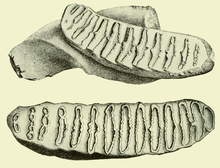Loxodonta atlantica
| Loxodonta atlantica Temporal range: Pliocene to Late Pleistocene
| |
|---|---|

| |
| Scientific classification | |
| Domain: | Eukaryota |
| Kingdom: | Animalia |
| Phylum: | Chordata |
| Class: | Mammalia |
| Order: | Proboscidea |
| Family: | Elephantidae |
| Genus: | Loxodonta |
| Species: | †L. atlantica
|
| Binomial name | |
| †Loxodonta atlantica Pomel, 1879
| |
Loxodonta atlantica is an extinct species of elephant in the genus Loxodonta, from Africa. It was larger than the modern African elephant, with more progressive dentition.[1] It includes Pleistocene fossils from Ternifine,[2] Middle Pleistocene fossils from Elandsfontein and Late Pliocene fossils from the Omo River, with a final dating in the Late Pleistocene.[3][4] L. atlantica was said to probably derive from L. adaurora;[5] however, an analysis in 2009 suggested that L. atlantica evolved from L. exoptata, and is ancestral to L. africana.[6] The species is divided into two subspecies: L. atlantica atlantica (northern Africa) and L. atlantica zulu (southern Africa).[5] The type for Loxodonta atlantica is housed in the Muséum national d'histoire naturelle in Paris, but is listed without a specimen number.[6]
References
- ^ Owen-Smith, R. Norman (1988). Megaherbivores: the influence of very large body size on ecology. Cambridge University Press. ISBN 0-521-36020-X.
- ^ Geraads, D. (1987). "Dating the Northern African cercopithecid fossil record". Human Evolution. 2: 19–27. doi:10.1007/BF02436528.
- ^ Carruthers, Jane; Boshoff, André; Slotow, Rob; Biggs, Harry C.; Avery, Graham; Matthews, Wayne (2008). "The Elephant in South Africa: History and Distribution". In Scholes, R. J.; Mennell, K. G. (eds.). Elephant management: A Scientific Assessment for South Africa. Wits University Press. pp. 23–83. doi:10.18772/22008034792. ISBN 978-1-86814-479-2.
{{cite book}}:|access-date=requires|url=(help); External link in|chapterurl=|chapterurl=ignored (|chapter-url=suggested) (help); Unknown parameter|displayauthors=ignored (|display-authors=suggested) (help) - ^ Kingdon, Jonathan; Happold, David; Butynski, Thomas; Hoffmann, Michael; Happold, Meredith; Kalina, Jan (23 May 2013). Mammals of Africa. A&C Black. ISBN 978-1-4081-8996-2.
{{cite book}}: Unknown parameter|displayauthors=ignored (|display-authors=suggested) (help) - ^ a b Coppens, Y.; Maglio, V. J.; Madden, C. T.; Beden, M. (1978). "Proboscidea". In Maglio, V. J.; Cooke, H. B. S. (eds.). Evolution of African mammals. Cambridge MA: Harvard University Press. pp. 336–367. ISBN 0-674-27075-4.
- ^ a b Todd, Nancy E. (2010). "New Phylogenetic Analysis of the Family Elephantidae Based on Cranial‐Dental Morphology". The Anatomical Record: Advances in Integrative Anatomy and Evolutionary Biology. 293 (1): 74–90. doi:10.1002/ar.21010.
